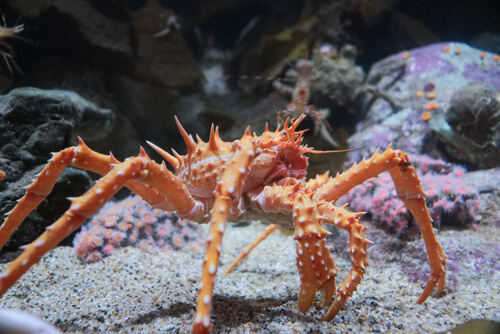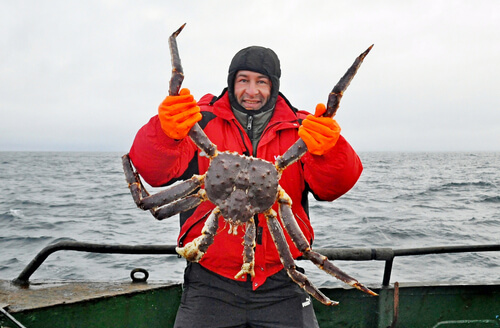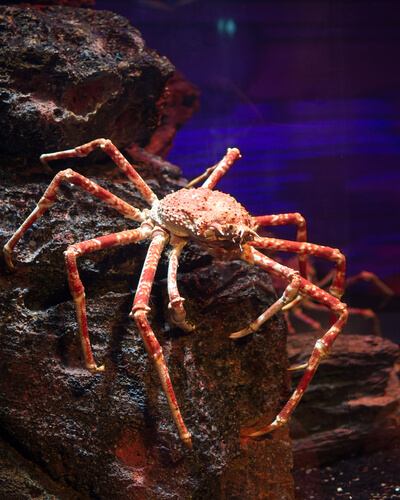
| Kingdom | Animalia |
| Phylum | Arthropoda |
| Class | Malacostraca |
| Order | Decapoda |
| Family | Lithodidae |
| Genus | Paralithodes |
| Species | P. camtschaticus |
| Niche | Benthic crustacean |
| Length | 5.9 ft (1.8 m) across |
| Weight | 28 lb (12.7 kg) |
| Lifespan | 20-30 years |
| Social Structure | Dense social groups |
| Conservation Status | No special status |
| Preferred Habitat | Sandy or rocky substrates in cold waters |
| Average Number of Eggs | 50,000-500,000 |
| Prey Species | Various marine invertebrates |
| Predators | Octopus, sharks, fish |
The Basics
The red king crab, also known as the Alaskan king crab or Kamchatka king crab, is the largest species of king crab native to the far northern Pacific ocean. It is famous for the large fishery in this area which targets this species.

Description
The red king crab is a large species of crab with a carapace of about 11 inches across and a leg span of nearly 6 feet. Males grow larger than females, with the largest individuals weighing about 28 pounds. It has a hard shell or exoskeleton covered in short, hard spines for additional protection.
Like other true crabs, prawn, and lobsters, the king crab is a decapod, with ten legs. Despite their name, which refers to their color once cooked, they appear a burgundy or brown color.
Distribution and Habitat
The red king crab is native to the north Pacific ocean. This species can also be found in the Bering Sea and was introduced to the Barents Sea in the 1960s. Preferring cold waters, it has been observed in waters ranging from roughly 29-55 °F. When young, the red king crab tends to inhabit shallow waters of less than 65 feet deep. Once they reach approximately two years of age, individuals will normally be found between 65-165 feet of water. At this stage, they will often take part in ‘podding’, where hundreds of crabs come together at night in large, highly concentrated groups. This provides them with protection from predators as they are still not fully grown. Adult king crabs eventually inhabit waters of more than 650 feet deep on sandy substrates, although they will move to shallower, rocky areas to mate.

Diet and Predators
The red king crab is an omnivorous species, feeding on almost anything it can. This includes feeding on dead and decaying plant and animal material as well as hunting a variety of invertebrate species, using their front limbs to hold and manipulate food and prey.
In its native range, the red king crab may face predation from a variety of species of sharks, fish, cephalopods, and whales. This depends largely on their life stage, with larger, more mature crabs being much less susceptible to predation. The giant pacific octopus is one of the most voracious predators of crabs in the red king crab’s native range. Humans also regularly prey on the red king crab, with it forming one of the largest crab fisheries in the world.
Reproduction
Fertilization in the red king crab occurs internally, with the females brooding the fertilized eggs on the underside of her abdomen for up to one year. During the winter when surface waters are sufficiently cold, individuals will travel to shallower waters to mate. In the case of already impregnated females, this migration occurs in order to spawn, releasing the young into the water column and mating again before retreating to deeper waters again in the summer. Females will release somewhere between 50,000 and 500,000 larval crabs during each spawning event, normally once per year throughout their lifespan, normally 20-30 years.
Conservation
The red king crab is the target of a large and valuable fishery that is generally considered well managed and with viable populations remaining throughout most of its native and introduced range. Because this species is normally captured using traps rather than trawling the seabed, it is not as destructive as other commercial fisheries. This is further aided by the fact that adult members of the species tend to inhabit sandy substrates rather than rocky substrates or other more sensitive ecosystems. The species is invasive in some parts of Europe and besides protection for the purpose of regulating fisheries, it does not receive any special protection for conservation purposes.
Fun Facts about the Red King Crab!
If you’ve ever had ‘king crab legs’ then you’ve probably already been acquainted with the red king crab. However, the species is fascinating and allows us to explore many fun facts and interesting biological concepts beyond simply appearing on our dinner plates as crab legs.
The Red Crab
The red king crab is native to the north Pacific ocean and the Bering Sea. However, in the 1960s it drew the attention of another large red entity. The former Soviet Union attempted to introduce the species to the Murmansk Fjord, a part of the Barents Sea closer to Europe. Their goal was to create a new, viable, and prosperous fishery in this area.
The first group of crabs were transported overland but did not survive the trip. Instead, some were flown in. These survived and established a population in this area, where it is now classified as an invasive species.
Stalin’s Crabs
Although the introduction of some species to novel environments may seem innocuous enough at a glance, there are often unforeseen circumstances that can be devastating to the ecosystem. In the case of the red king crab, it has become problematic in the Barents Sea where it was introduced.
With one of its most significant natural predators, the giant Pacific octopus, not present in European waters, this population has grown largely unchecked for decades and is now very numerous. As it is an omnivore, the species will eat almost anything in its path. According to local fishermen and researchers, effectively creating ‘desserts’ largely devoid of native species and life in general.
Since the 1960s, the species has also reached the Norwegian coast and continues to advance southward about 30 miles per year. This has raised fears that similar effects that have been observed in the Barents Sea will also occur here, with particular concern for the cod breeding ground near Lofoten being expressed. There is also some evidence that the species prefers to feed on the egg masses of the capelin, a small species of fish that is an important food source for Cod. Because of these threats, the locals have largely taken to villanizing the species, referring to them as ‘Stalin’s Crabs’.

Molting and Exoskeletons
Like in all decapods, the red king crab’s shell truly is a skeleton on the outside of its body. In contrast to the endoskeletons present in humans, for example, the exoskeleton does not expand. Therefore individuals must molt or shed their shells regularly to grow bigger. Before this, an individual begins building a new, larger skeleton inside the existing one. As it becomes bigger, it will no longer be containable by the existing shell, eventually splitting it open. After removing itself from the old outer shell, the new exoskeleton hardens further. However, the new exoskeleton can be soft for several days leaving the crab more vulnerable to predation than it would be otherwise.
Doesn’t Hold its Breath
The red king crab has gills like fishes or sharks that allow it to respire underwater. Within the carapace – the main body of the crab – exists two branchial chambers. Within this chamber lie the gills, which are covered in a hard chitinous cuticle layer that is permeable to gases, allowing for the exchange of oxygen over this layer. To ensure the movement of water within the branchial chamber, the crab uses a unique appendage known as a scaphognathite. This ultimately draws water in from behind the crab’s walking legs while expelling it through openings known as prebronchial apertures, located beside its mouth.
